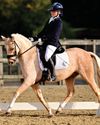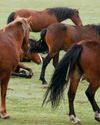Disorders of the endocrine system — the body’s hormone-producing glands — can result in ongoing health issues and a high risk of laminitis. Edd Knowles MRCVS and Andy Durham MRCVS discuss the latest findings.

IN the past few years, there has been a huge growth in research into equine hormonal disease, something we now commonly recognise in both horses and ponies in the UK.
Researchers from around the world gathered earlier this year at the Havemeyer Foundation International Summit in Florida, USA, to discuss their progress, shedding valuable light on the cause and treatment of these complex conditions.
There are two common hormonal (or endocrine) conditions that affect horses: PPID (pituitary pars intermedia dysfunction, also known as Cushing’s disease) and EMS (equine metabolic syndrome). The conditions share some similarities and both have links with laminitis, but there are also important differences between them.
PPID usually occurs in ageing horses, especially from the mid-teens onwards, although younger cases are recognised. The pituitary gland, found dangling just below the brain, produces a range of different hormones that work as messengers in the body, controlling different processes such as growth, breeding cycles and response to stress. When PPID develops, part of the pituitary gland becomes overactive and produces too many hormones.
Signs of PPID can vary, ranging from abnormal hair growth or delayed coat shedding to muscle loss, excessive drinking and urinating, laminitis, lack of energy and recurring infections. We can all spot the telltale signs of severe, advanced PPID — the long curly coat and the pot belly, but vets often use blood tests to identify PPID in horses with more subtle signs. Accurate diagnosis is important, because some of these issues could also be caused by other conditions.
This story is from the {{IssueName}} edition of {{MagazineName}}.
Start your 7-day Magzter GOLD free trial to access thousands of curated premium stories, and 9,000+ magazines and newspapers.
Already a subscriber ? Sign In
This story is from the {{IssueName}} edition of {{MagazineName}}.
Start your 7-day Magzter GOLD free trial to access thousands of curated premium stories, and 9,000+ magazines and newspapers.
Already a subscriber? Sign In

'Sorry, but I wasn't feeling it'
Fresh from the opening meet, Tessa Waugh hasn't quite yet been bitten by the hunting bug. Without the crisp autumnal air and cheek-pinching cold she hoped for, it's a sluggish start

New pair pull off a win
A former European Championships pony is on form with his new rider, while elsewhere former showjumpers and eventers take ribbons

Lording it over the rest
Horses who have returned from injury, a second generation homebred and a long format specialist score on the final weekend of the British season

Smith hits flying form
A \"her way or no way\" mare helps Zoe Smith to an impressive ribbon haul and a rider beats his own boss to the top spot

Jankorado hits the jackpot
Paul Sims is triumphant despite his interrupted jump-off preparation and a borrowed horse comes up trumps

Peanut
From \"dangerous, scary\" to hedge-hopping brilliance, hunting has been the making of this unstable but very lovable equine character

She's a corker
Communication, says long-standing and highly respected Belvoir master Lady Sarah McCorquodale, is the key to all, as Catherine Austen discovers

Access all areas Cavalier Centre
The Cavalier Centre is a fully accessible, state-of-the-art equestrian centre designed to improve lives through horse-based activities. Ellie May Forrester pays a visit

'Use it or lose it'
Not everyone wants to reach for the pipe and slippers at a certain age. Becky Murray speaks to some veteran horse-and-rider combos for their secrets of human and equine longevity

A new way forward
Worm control in horses is vital, but established methods will not remain effective for much longer. Tim Mair FRCVS explains why and how we need to change